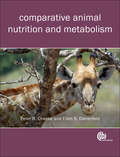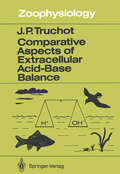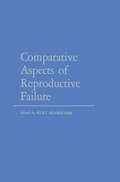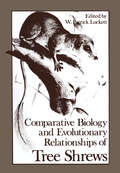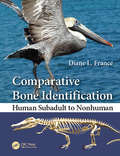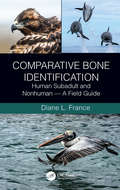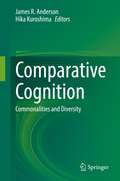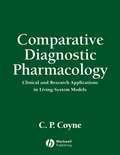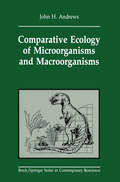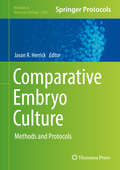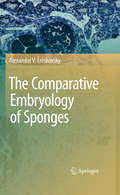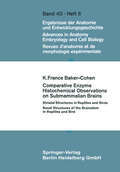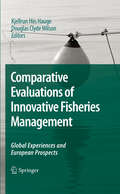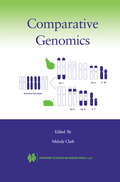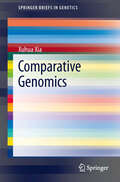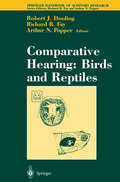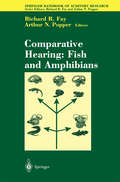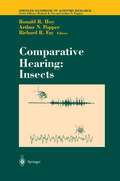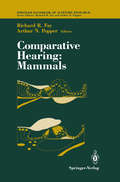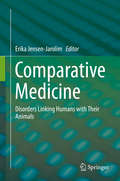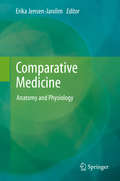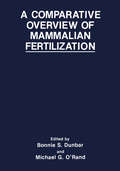- Table View
- List View
Comparative Animal Nutrition and Metabolism
by Peter Cheeke Ellen DierenfeldNutrition is a very broad discipline, encompassing biochemistry, physiology, endocrinology, immunology, microbiology and pathology. Presenting the major principles of nutrition of both domestic and wild animals, this book takes a comparative approach, recognising that there are considerable differences in nutrient digestion, metabolism and requirements among various mammalian and avian species. Explaining species differences in food selection, food-seeking and digestive strategies and their significance to nutritional needs, chapters cover a broad range of topics including digestive physiology, metabolic disorders and specific nutrients such as carbohydrates proteins and lipids, with particular attention being paid to nutritional and metabolic idiosyncrasies. It is an essential text for students of animal and veterinary sciences.
Comparative Animal Nutrition and Metabolism (PDF)
by Peter Cheeke Ellen DierenfeldNutrition is a very broad discipline, encompassing biochemistry, physiology, endocrinology, immunology, microbiology and pathology. Presenting the major principles of nutrition of both domestic and wild animals, this book takes a comparative approach, recognising that there are considerable differences in nutrient digestion, metabolism and requirements among various mammalian and avian species. Explaining species differences in food selection, food-seeking and digestive strategies and their significance to nutritional needs, chapters cover a broad range of topics including digestive physiology, metabolic disorders and specific nutrients such as carbohydrates proteins and lipids, with particular attention being paid to nutritional and metabolic idiosyncrasies. It is an essential text for students of animal and veterinary sciences.
Comparative Aspects of Extracellular Acid-Base Balance (Zoophysiology #20)
by Jean-Paul TruchotInterest in comparative acid-base physiology has considerably grown during last decades even in the absence of major technical or conceptual advances. This is firstly because it has become clear that the extracellular acid-base state reflects the performance of many exchange functions at the organism level: respiration and ventilation of the gas exchange surfaces, metab olism, iono-and osmoregulation. Such functions are much in fluenced by ambient conditions, and the measurement of acid base parameters thus provides useful information about the organism's responses to environmental challenges. Secondly, many processes at the molecular level are now known to be pH sensitive, and acid-base regulation thus appears to be a major requirement for the functional integrity of cells and organisms. How extracellular acid-base balance can be maintained in a wide variety of animals living in different conditions is the sub ject of this book. The approach is comparative and environ mental throughout. All body fluids share similar buffer proper ties, and common physicochemical principles apply to any acid base system. However, in accord with differing designs and con straints along animal evolution, varying effector organs and mechanisms are at work to maintain an appropriate acid-base state in the organism. Particular emphasis is placed on the fun damental differences between water and air breathers and on the acid-base and respiratory problems arising at the transition from an aquatic to a terrestrial life. Also the complex array of factors influencing the acid-base state in water-dwelling animals is thoroughly discussed.
Comparative Aspects of Reproductive Failure: An International Conference at Dartmouth Medical School, Hanover, N.H.—July 25–29, 1966
by K. BenirschkeTo many, the contents of this conference may not seem appropriate at a time when the minds are preoccupied with a "population explosion." To the participants and guests of this conference, however, this was a week of fascinating discussions. While quantitative aspects of reproduc tion were touched upon, it was mostly a search for an understanding of the qualitative aspects of reproduction and its failure. Only when we understand these more completely will it be possible to render optimum care and have the foundations for meaningful population control. The conference was conceived in discussions at the Committee on Pathology of the National Academy of Sciences, W"ashington, in 1965. It was felt that investigators in medicine and the veterinary fields would profit greatly from a closer liaison. All too frequently, we work relatively isolated in our respective fields and, with the burgeoning information filling our journals, we have not enough time and leisure to stand back and attempt a comparative look at the subject of study. Often we are not familiar with the techniques other disciplines use, and which we could well employ to great advantage. ,,yhile this applies to many aspects of medicine, a comparative approach to the study of reproductive failure seemed most advantageous at this time.
Comparative Biology and Evolutionary Relationships of Tree Shrews (Advances in Primatology)
by W. Patrick LuckettTree shrews are small-bodied, scansorial, squirrel-like mammals that occupy a wide range of arboreal, semi-arboreal, and forest floor niches in Southeast Asia and adjacent islands. Comparative aspects of tree shrew biology have been the subject of extensive investigations during the past two decades. These studies were initiated in part because of the widely accepted belief that tupaiids are primitive primates, and, as such, might provide valuable insight into the evolutionary origin of complex patterns of primate behavior, locomotion, neurobiology, and reproduction. During the same period, there has been a renewed interest in the methodology of phylogenetic reconstruction and in the use of data from a variety of biological disciplines to test or formulate hypotheses of evolutionary relationships. In particular, interest in the com parative and systematic biology of mammals has focused on analysis of phy logenetic relationships among Primates and a search for their closest relatives. Assessment of the possible primate affinities of tree shrews has comprised an important part of these studies, and a considerable amount of dental, cranio skeletal, neuroanatomical, reproductive, developmental, and molecular evi dence has been marshalled to either corroborate or refute hypotheses of a special tupaiid-primate relationship. These contrasting viewpoints have re sulted from differing interpretations of the basic data, as well as alternative approaches to the evolutionary analysis of data.
Comparative Bone Identification: Human Subadult to Nonhuman
by Diane L. FranceBuilding on the success, and maintaining the format, of the best-selling Human and Nonhuman Bone Identification: A Color Atlas (ISBN: 978-1-4200-6286-1), Comparative Bone Identification: Human Subadult to Nonhuman presents new images of human bones representing many states of maturation from neonate to 20 years old. It also extends the scope of the former work by focusing on the smaller bones of fetuses and young humans and comparing them to bones of birds, reptiles, marine mammals, fish, and a frog that may be confused with those of a subadult human. The book begins with a section on general osteology and explains the major anatomical differences between humans and other animals. The second section compares human and nonhuman bones, categorized by type of bone, and includes most of the major bones in humans and nonhumans. The third section presents skeletons within species. Containing nearly 3,500 color photographs, the book provides examples of similar bones in nonhuman species that may be confused with the human bone in question. The bone images are also taken from different angles to enhance detailed understanding. A practical comparative guide to the differences among species for nearly all bones in the body, this book is a valuable resource for the laboratory or in the field. It uses a visual approach with annotations pointing out salient features of the most commonly discovered bones, giving clear examples for use by law enforcement, medicolegal death investigators, forensic anthropologists, students, and readers who wish to distinguish between human bones and those of the a variety of animal species.
Comparative Bone Identification: Human Subadult and Nonhuman - A Field Guide
by Diane L. FranceBuilding on the success, and maintaining the format, of Comparative Bone Identification: Human Subadult and Non-Human (ISBN: 9780367777883), Comparative Bone Identification: Human Subadult and Non-Human – A Field Guide presents new images of human bones representing many states of maturation from neonate to 20 years old in comparison to a variety of animal species’ bones. Highly illustrated, the book takes a visual approach and provides full annotations pointing out salient features of the most commonly discovered bones. This includes smaller bones of fetuses and subadult humans in comparison to bones of birds, reptiles, marine mammals, fish, and a frog that human bones may most be confused with. Full-color photos provide clear examples for use by law enforcement, medicolegal death investigators, forensic anthropologists, students, and readers who wish to distinguish between human bones and those of a variety of animal species. The book is not intended to be an exhaustive guide to human and nonhuman skeletons. It offers myriad photos and illustrations to help aid in identification and avoid some of the more commonly confused animal bones for human. The book begins with an introduction section on general osteology and explains the major anatomical differences between humans and other animals. The second section compares human and nonhuman bones, categorized by type of bone, and includes most of the major bones in humans and nonhumans. The third section presents of radiographs illustrated documented age in humans. Conveniently designed for field use, Comparative Bone Identification: Human Subadult to Nonhuman – A Field Guide offers users a practical comparative guide that presents the differences among species for nearly all bones in the body. The book serves as a valuable resource of easy-to-access information to investigators and forensic anthropologists for use in the laboratory or in the field.
Comparative Bone Identification: Human Subadult to Nonhuman
by Diane L. FranceBuilding on the success, and maintaining the format, of the best-selling Human and Nonhuman Bone Identification: A Color Atlas (ISBN: 978-1-4200-6286-1), Comparative Bone Identification: Human Subadult to Nonhuman presents new images of human bones representing many states of maturation from neonate to 20 years old. It also extends the scope of the former work by focusing on the smaller bones of fetuses and young humans and comparing them to bones of birds, reptiles, marine mammals, fish, and a frog that may be confused with those of a subadult human. The book begins with a section on general osteology and explains the major anatomical differences between humans and other animals. The second section compares human and nonhuman bones, categorized by type of bone, and includes most of the major bones in humans and nonhumans. The third section presents skeletons within species. Containing nearly 3,500 color photographs, the book provides examples of similar bones in nonhuman species that may be confused with the human bone in question. The bone images are also taken from different angles to enhance detailed understanding. A practical comparative guide to the differences among species for nearly all bones in the body, this book is a valuable resource for the laboratory or in the field. It uses a visual approach with annotations pointing out salient features of the most commonly discovered bones, giving clear examples for use by law enforcement, medicolegal death investigators, forensic anthropologists, students, and readers who wish to distinguish between human bones and those of the a variety of animal species.
Comparative Cognition: Commonalities and Diversity
by James R. Anderson Hika KuroshimaThis book presents an overview of selected topics in comparative cognition, which is the study of behaviour and mental activities in nonhuman animals. Human psychological capacities are often used as a heuristic by comparative cognitive scientists, whose tasks include designing valid procedures for studying species’ sensory, linguistic or manipulatory abilities that differ from those of humans. Nonetheless, researchers have developed many original ways to gain insights into how other species perceive the world, store and integrate information, and communicate. The contributors to this book have all been involved in such work, and will present some of the approaches that have led to clear advances in our understanding of cognitive processes in other species. The chapters integrate a review of past literature with recent work, covering a variety of subject species including birds, domestic dogs and cats, and nonhuman primates. All contributors have worked with or been otherwise influenced by Professor Kazuo Fujita, to whom the volume will be dedicated. Fujita’s openness to research on various topics and species is reflected in the diversity of the chapters presented.The book will be of interest to students and more experienced researchers in diverse fields including psychology, anthropology, biology and veterinary studies.
Comparative Diagnostic Pharmacology: Clinical and Research Applications in Living-System Models
by C.P. CoyneComparative Diagnostic Pharmacology: Clinical and Research Applications in Living-System Models is the first evidence-based reference text devoted exclusively to the subject of applying pharmaceutical and biopharmaceutical agents as diagnostic probes in clinical medicine and investigative research.This unique and groundbreaking book is a versatile guide for clinicians and researchers interested in using pharmacologic agents to: Diagnose disease Assess physiological processes Identify the appropriateness of a therapeutic agent Determine appropriate dosing for therapeutic use. Extensively referenced and organized by major body systems, individual topics are listed in an evidence-based format according to specific disease processes or physiological processes of interest. Each entry also includes information on the mechanism of action, administration, and diagnostic interpretation. Descriptions have been provided for the application of diagnostic pharmaceuticals to assess a wide spectrum of diseases and physiological processes relevant to the fields of veterinary and human medicine. Comparative Diagnostic Pharmacology is useful not merely for pharmaceutical-oriented research investigations, but it will also prove invaluable for the monitoring and evaluation of physiological responses and disease processes in animal models.
Comparative Ecology of Microorganisms and Macroorganisms (Brock Springer Series in Contemporary Bioscience)
by John H. AndrewsThe most important feature of the modern synthetic theory of evolution is its foundation upon a great variety of biological disciplines. -G. L. STEBBINS, 1968, p. 17 This book is written with the goal of presenting ecologically significant anal ogies between the biology of microorganisms and macroorganisms. I consider such parallels to be important for two reasons. First, they serve to emphasize that however diverse life may be, there are common themes at the ecological level (not to mention other levels). Second, research done with either microbes or macroorganisms has implications which transcend a particular field of study. Although both points may appear obvious, the fact remains that at tempts to forge a conceptual synthesiS are astonishingly meager. While unify ing concepts may not necessarily be strictly correct, they enable one to draw analogies across disciplines. New starting points are discovered as a conse quence, and new ways of looking at things emerge. The macroscopic organisms ('macroorganisms') include most represen tatives of the plant and animal kingdoms. I interpret the term 'microorganism' (microbe) literally to mean the small or microscopic forms of life, and I include in this category the bacteria, the protists (excluding the macroscopic green, brown, and red algae), and the fungi. Certain higher organisms, such as many of the nematodes, fall logically within this realm, but are not discussed at any length.
Comparative Embryo Culture: Methods and Protocols (Methods in Molecular Biology #2006)
by Jason R. HerrickThis detailed volume contains embryo culture techniques that should inspire embryologists to consider comparative studies. The species included in this volume represent a broad range of taxa, whose embryos have vastly different culture requirements and developmental characteristics. Among the species described in this volume, significant differences exist in the rates of cell division, the timing of the maternal to embryonic transition, the relative lipid content of the cytoplasm, the sensitivity of the embryo to specific environmental ions, the preferred nutrients and associated metabolic pathways used by the embryo, the timing and mechanisms of early lineage specification, the presence or absence of embryonic diapause, and the time from fertilization to implantation. Written for the highly successful Methods in Molecular Biology series, chapters include introduction to their respective topics, lists of the necessary materials and reagents, step-by-step, readily reproducible protocols, and tips on troubleshooting and avoiding known pitfalls. Authoritative and practical, Comparative Embryo Culture: Methods and Protocols serves as an ideal aid for scientists seeking another species whose embryos have evolved a unique mechanism that could provide a valuable, comparative context for experimentation.
The Comparative Embryology of Sponges
by Alexander V. EreskovskyOne of the major questions in the evolution of animals is the transition from unicellular to multicellular organization, which resulted in the emergence of Metazoa through a hypothetical Urmetazoa. The Comparative Embryology of Sponges contains abundant original and literary data on comparative embryology and morphology of the Porifera (Sponges), a group of 'lower Metazoa'. On the basis of this material, original typization of the development of Sponges is given and the problems concerning origin and evolution of Porifera and their ontogenesis are discussed. A morphogenetic interpretation of the body plan development during embryogenesis, metamorphosis and asexual reproduction in Sponges is proposed. Special attention is given to the analysis of characteristic features of the ontogenesis in Porifera. The book pursues three primary goals: 1) generalization of all existing information on individual development of sponges, its classification and a statement according to taxonomical structure of Porifera; 2) revealing of heterogeneity of morphogenesis and peculiarities of ontogeneses in various clades of Porifera, and also their correlations with the organization, both adult sponges, and their larvae; 3) revealing homology of morphogeneses in both Porifera and Eumetazoa, testifying to the general evolutionary roots of multicellular animals, and peculiar features of sponges' morphogeneses and ontogenesis. This book will be of interest to embryologists, zoologists, morphologists and researchers in evolutionary biology.
Comparative Enzyme Histochemical Observations on Submammalian Brains (Advances in Anatomy, Embryology and Cell Biology #40/6)
by K.F. Baker-CohenComparative neurological studies of the evolutionary development of struc tures within the central nervous system of vertebrates have depended to a large extent upon morphological rather than functional criteria. Classical comparative anatomical studies, which have attempted to demonstrate homologies between parts of the brain in representatives of different vertebrate classes may be grouped under three general headings: 1. comparison of the embryological development of brain structures; 2. comparison in adult forms of the topographical relations of neuron groupings and fiber tracts, and of the morphology of cell types ( cyto architectonics); and 3. analysis and comparison of fiber connections between particular cell groupings or regions. Of these three, the third encompasses func tional relationships most directly, but even in well-defined fiber tracts the direction of conduction often remains indefinite, and the extent and activity of more diffuse systems is poorly known. In recent years a nurober of investigations applying electrophysiological and degeneration methods to submammalian forms have been reported. Those most pertinent to the present studies include the papers of . ARMSTRONG et al. (1953), KRUGERand associates (e. g. HERIC and KRUGER, 1966; KRUGERand BERKOWITZ, 1960; PowELL and KRUG ER, 1960}, GusEL'NIKov and SUPIN (1964) and KARA MYAN and BELEKJIOVA (1964) on various reptiles, and of PowELL and CowAN (1961), KARTEN and REVZIN (1966) and REVZIN and KARTEN (1967) on the pigeon.
Comparative Evaluations of Innovative Fisheries Management: Global Experiences and European Prospects
by Kjellrun Hiis Hauge Douglas Clyde WilsonComparative Evaluations of Innovative Fisheries Management begins with a look at four places outside the European Union known for innovative management: New Zealand, Nova Scotia, Alaska and Iceland. Then the focus shifts to the success criteria related to specific disciplines including biological and social robustness, economic efficiency and impacts on management costs. Hypotheses are tested using data capable of generating useful results. The main conclusions include a retrospective of how key concepts defined and represented the various perspectives, skills and backgrounds that made up the multidisciplinary CEVIS project.
Comparative Genomics
by Melody ClarkSince the advent of the Human Genome Project, an increasing number of disease-causing genes have been discovered and, in some cases, genetic tests developed. However, this is only the first step. The second, much larger phase is the analysis of the total sequence. What does the rest of the DNA do? The answer to this question will be determined by computer prediction, expression profiling, and comparative genome analysis. Comparative Genomics covers such topics as identifying novel genes, determining gene function, control sequences, and developmental switches. The book aims to demonstrate how different approaches taken with model organisms, such as mutation studies, expression profiling of cDNAs, in situ localization of message and comparative genome analysis (both at the gene and nucleotide level) will aid in our understanding of the results coming out of the Human Genome Project and contribute significantly to our understanding of how genes function.
Comparative Genomics (SpringerBriefs in Genetics)
by Xuhua XiaThis book provides an evolutionary conceptual framework for comparative genomics, with the ultimate objective of understanding the loss and gain of genes during evolution, the interactions among gene products, and the relationship between genotype, phenotype and the environment. The many examples in the book have been carefully chosen from primary research literature based on two criteria: their biological insight and their pedagogical merit. The phylogeny-based comparative methods, involving both continuous and discrete variables, often represent a stumbling block for many students entering the field of comparative genomics. They are numerically illustrated and explained in great detail. The book is intended for researchers new to the field, i.e., advanced undergraduate students, postgraduates and postdoctoral fellows, although professional researchers who are not in the area of comparative genomics will also find the book informative.
Comparative Hearing: Birds and Reptiles (Springer Handbook of Auditory Research #13)
by Robert J. Dooling Richard R. FayBirds and reptiles have long fascinated investigators studying hearing and the auditory system. The highly evolved auditory inner ear of birds and reptiles shares many characteristics with the ear of mammals. Thus, the two groups are essential in understanding the form and function of the vertebrate and mammalian auditory systems. Comparative Hearing: Birds and Reptiles covers the broad range of our knowledge of hearing and acoustic communication in both groups of vertebrates. This volume addresses the many similarities in their auditory systems, as well as the known significant differences about hearing in the two groups.
Comparative Hearing: Fish and Amphibians (Springer Handbook of Auditory Research #11)
by Richard R. FayExperimental approaches to auditory research make use of validated animal models to determine what can be generalized from one species to another. This volume brings together our current understanding of the auditory systems of fish and amphibians. To address broader comparative issues, this book treats both fish and amphibians together, to overcome the differing theoretical and experimental paradigms that underlie most work on these groups.
Comparative Hearing: Insects (Springer Handbook of Auditory Research #10)
by Ronald R. Hoy Richard R. FayThe Springer Handbook of Auditory Research presents a series of compre hensive and synthetic reviews of the fundamental topics in modern auditory research. The volumes are aimed at all individuals with interests in hearing research, including advanced graduate students, postdoctoral researchers, and clinical investigators. The volumes are intended to introduce new in vestigators to important aspects of hearing science and to help established investigators to better understand the fundamental theories and data in fields of hearing that they may not normally follow closely. Each volume is intended to present a particular topic comprehensively, and each chapter serves as a synthetic overview and guide to the literature. As such, the chapters present neither exhaustive data reviews nor original research that has not yet appeared in peer-reviewed journals. The volumes focus on topics that have developed a solid data and conceptual foundation, rather than on those for which a literature is only beginning to develop. New research areas will be covered on a timely basis in the series as they begin to mature.
Comparative Hearing: Mammals (Springer Handbook of Auditory Research #4)
by Richard R. FayThe Springer Handbook of Auditory Research presents a series of comprehen sive and synthetic reviews of the fundamental topics in modern auditory research. The volumes are aimed at all individuals with interests in hearing research including advanced graduate students, postdoctoral researchers, and clinical investigators. The volumes are intended to introduce new investi gators to important aspects of hearing science and to help established inves tigators to better understand the fundamental theories and data in fields of hearing that they may not normally follow closely. Each volume is intended to present a particular topic comprehensively, and each chapter will serve as a synthetic overview and guide to the lit erature. As such, the chapters present neither exhaustive data reviews nor original research that has not yet appeared in peer-reviewed journals. The volumes focus on topics that have developed a solid data and conceptual foundation rather than on those for which a literature is only beginning to develop. New research areas will be covered on a timely basis in the series as they begin to mature. Each volume in the series consists of five to eight substantial chapters on a particular topic. In some cases, the topics will be ones of traditional interest for which there is a substantial body of data and theory, such as auditory neuroanatomy (Vol. 1) and neurophysiology (Vol. 2). Other volumes in the series will deal with topics which have begun to mature more recently, such as development, plasticity, and computational models of neural processing.
Comparative Medicine: Disorders Linking Humans with Their Animals
by Erika Jensen-JarolimThis book highlights the most significant diseases for humans and their dogs, cats and horses. The examples discussed, which include allergies, osteoporosis, cancer and many more, illustrate that humans and their companion animals may in fact develop similar diseases. The reader - whether expert or interested lay - can thus directly compare between human and animal patients. The animal patient thereby represents a natural disease model, which besides the experimental models, is urgently needed to improve the therapeutic options for both humans and animals.
Comparative Medicine: Anatomy and Physiology
by Erika Jensen-JarolimThis new volume provides a concise overview of the most basic and exciting chapters of comparative medicine with regards to physiology and function in healthy individuals. The book includes core concepts in anatomy and physiology in human and animal models, which are key to understanding comparative medicine and to making contributions to research in this area. While writing this book, the authors were in constant interdisciplinary dialogue. They aim to contribute to improvements in quality of life for human and animal patients.
Comparative Neuropathology
by J. R. Innes L. Z. SaundersComparative Neuropathology focuses on documented accounts of neurologic diseases and congenital defects in animals. The book first offers information on neuropathology, neuroanatomy, and cerebrospinal fluid (CSF). The domesticated animals that have CSF include horses, dogs, pigs, cats, rabbits, and cattle. The text then elaborates on neurologic diseases of apes and monkeys. Discussions focus on confluent leucoencephalosis and perivascular myelosis, encephalopathies and dysenteric syndromes, meningitis, epilepsies, tuberculosis, cerebellar atrophy and experimental manganese poisoning, and choreic syndrome in baboons with corticostriate encephalitis. The publication examines the diseases of the skeletal muscle and hypophysis, including general reactions of muscles to injuries, congenital defects, muscular dystrophies, changes in muscle associated with specific diseases, and tumor. The manuscript also takes a look at inherited diseases and congenital anomalies, protozoan and bacterial infections, and demyelinating or myelinoclastic diseases. The text is a dependable reference for readers interested in comparative neuropathology.
A Comparative Overview of Mammalian Fertilization
by Bonnie S. Dunbar M. G. O'RandIn 1964, the Fertilization and Gamete Physiology Research Training Program (FERGAP) was established at the Marine Biological Laboratories, Woods Hole, Massachusetts. Over the course of the next 12 years, under the directorship of Dr. Charles B. Metz, FERGAP brought together, trained, and inspired a generation of students in reproductive biology from all over the world. As students of C. B. Metz and as FERGAP trainees, we would like to dedicate this collected work on comparative mammalian fertilization to our teacher and mentor, Dr. Charles B. Metz. Like a number of authors contributing to this volume, we have been struck by the significant impact that C. B. Metz and FERGAP had on the development of students of reproductive biology. Applying both the classical and molecular techniques of cell biology and immunology to problems of gamete biology, Dr. Metz emphasized a comparative and analytical approach that was reflected in his own research on fertilization in Paramecia, sea urchins, frogs, and mammals. It is hoped that this volume will serve to stimulate students to discover the myriad of fascinating research problems in gamete and reproductive biology. Bonnie S. Dunbar Michael G. O'Rand Houston, Texas Chapel Hill, North Carolina ix Contents Part I COMPARATIVE OVERVIEW OF MAMMALIAN GAMETES The Coevolution of Mammalian Gametes . . . . . . . . . . . . . . . . . . . . . . . . . . . . . . . . 3 J. Michael Bedford I. Introduction . . . . . . . . . . . . . . . . . . . . . . . . . . . . . . . . . . . . . . . . . . . . . . . . . . . . . 3 2. Gamete Design . . . . . . . . . . . . . . . . . . . . . . . . . . . . . . . . . . . . . . . . . . . . . . . . . . 4 2.1. Monotremes . . . . . . . . . . . . . . . . . . . . . . . . . . . . . . . . . . 5 . . . . . . . . . . . . . . 2.2. Marsupials . . . . . . . . . . . . . . . . . . . . . . . . . . . . . . . . . . 5 . . . . . . . . . . . . . . . 2.3. Eutherians . . . . . . . . . . . . . . . . . . . . . . . . . . . . . . . . . . . . . . . . . . . . . . . . . 9 3. Gamete Maturation . . . . . . . . . . . . . . . . . . . . . . . . . . . . . . . . 14 . . . . . . . . . . . . . . . 3 .1. Oocyte Maturation . . . . . . . . . . . . . . . . . . . . . . . . . . . . . . 14 . . . . . . . . . . . . . 3.2. Sperm Maturation in the Male . . . . . . . . . . . . . . . . . . . . . . . 15 . . . . . . . . . .
